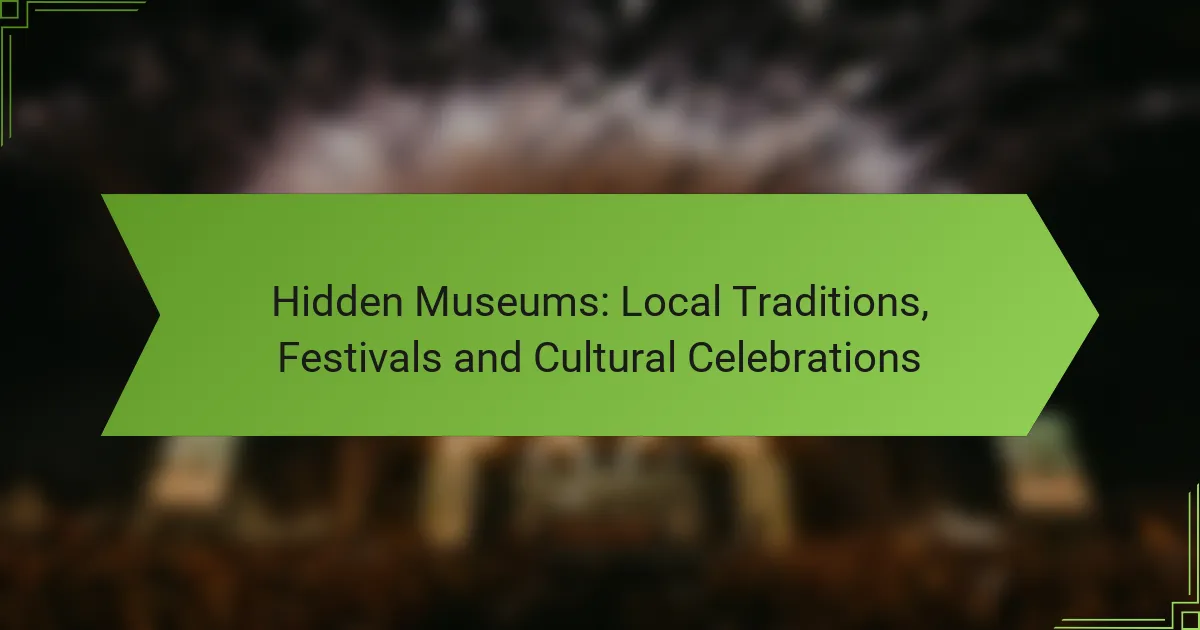Hidden museums offer a treasure trove of unique experiences that highlight cultural heritage and local art, often escaping the notice of mainstream tourism. These venues invite visitors to delve into unconventional themes and artifacts, revealing compelling stories that enrich our understanding of community identity and artistic expression.

What Are the Best Hidden Museums to Visit?
Hidden museums offer unique experiences that showcase cultural heritage and local art, often overlooked by mainstream tourism. These venues provide a chance to explore unconventional themes and artifacts that tell compelling stories.
The Museum of Jurassic Technology
Located in Los Angeles, the Museum of Jurassic Technology combines art, science, and history in a whimsical setting. It features exhibits that blur the lines between fact and fiction, showcasing curiosities like miniature dioramas and obscure scientific artifacts.
Visitors should prepare for an immersive experience that encourages exploration at a leisurely pace. The museum’s intimate atmosphere allows for personal reflection on the exhibits, making it a unique stop for those interested in the intersection of art and science.
The Museum of Broken Relationships
This museum, with locations in Zagreb and Los Angeles, focuses on the theme of heartbreak and relationships. It displays personal objects donated by people from around the world, each accompanied by a story that reflects the emotional weight of lost love.
When visiting, expect a poignant experience that invites contemplation on human connections. The exhibits are often relatable, making it a powerful space for anyone who has experienced love and loss.
The International Cryptozoology Museum
Situated in Portland, Maine, this museum is dedicated to the study of hidden or legendary animals, such as Bigfoot and the Loch Ness Monster. It features a range of exhibits, including artifacts, photographs, and educational materials that explore the science and folklore surrounding cryptids.
Visitors can engage with the intriguing world of cryptozoology, learning about the cultural significance of these creatures. The museum often hosts events and lectures, making it a great destination for enthusiasts and skeptics alike.
The Magic Castle
In Hollywood, California, The Magic Castle is a private club for magicians and magic enthusiasts, featuring performances and exhibits related to the art of magic. Access is typically granted through membership or by invitation, making it a unique experience for those who can attend.
Guests can enjoy a variety of magic shows, dine in a themed restaurant, and explore the castle’s intriguing history. It’s advisable to make reservations well in advance, as the venue is popular and often fully booked.
The Neon Museum
Located in Las Vegas, Nevada, The Neon Museum is dedicated to preserving iconic Las Vegas signs and neon art. The outdoor exhibition space, known as the Neon Boneyard, showcases a collection of restored and unrestored signs that reflect the city’s vibrant history.
Visitors can take guided tours to learn about the stories behind each sign, making it a fascinating stop for those interested in design and history. Evening tours are particularly enchanting, as many signs are illuminated, providing a magical atmosphere.
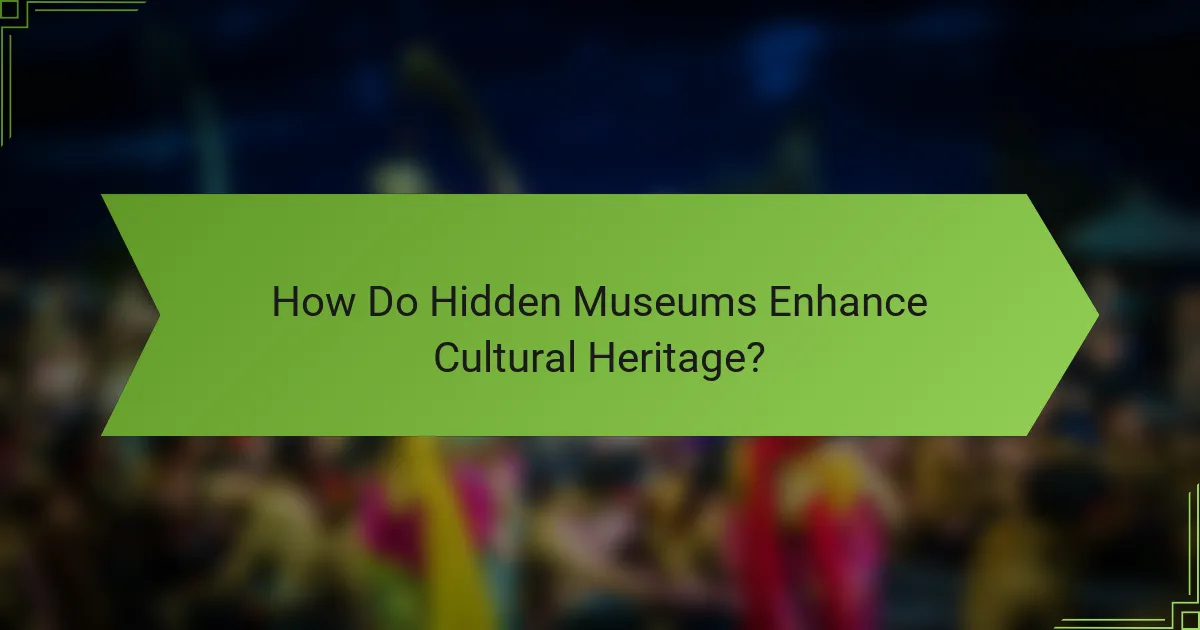
How Do Hidden Museums Enhance Cultural Heritage?
Hidden museums play a crucial role in enhancing cultural heritage by showcasing unique local art and artifacts that may otherwise go unnoticed. They provide a platform for preserving history and fostering a deeper understanding of community identity through diverse artistic expressions.
Preservation of Local Artifacts
Hidden museums often focus on the preservation of local artifacts that reflect the history and culture of a specific region. By curating collections that include everyday objects, traditional crafts, and historical items, these museums help maintain the narrative of local heritage.
For example, a hidden museum in a small town might display tools used by local artisans or agricultural implements that tell the story of the area’s development. This preservation not only safeguards these items but also educates visitors about their significance.
Promotion of Underrepresented Artists
Many hidden museums prioritize the promotion of underrepresented artists, providing them with a venue to showcase their work. This focus helps to diversify the artistic landscape and gives a voice to those who may not have access to mainstream galleries.
For instance, a hidden museum might feature emerging artists from marginalized communities, highlighting their unique perspectives and contributions to the local culture. By doing so, these institutions foster a richer cultural dialogue and encourage broader appreciation for diverse art forms.
Community Engagement Initiatives
Community engagement initiatives are a key aspect of hidden museums, as they often involve local residents in programming and decision-making. These initiatives can include workshops, artist talks, and collaborative exhibitions that invite community participation.
For example, a hidden museum might host a series of art classes for local youth, allowing them to learn from established artists while creating their own works. Such programs not only build skills but also strengthen community ties and promote a sense of ownership over cultural heritage.
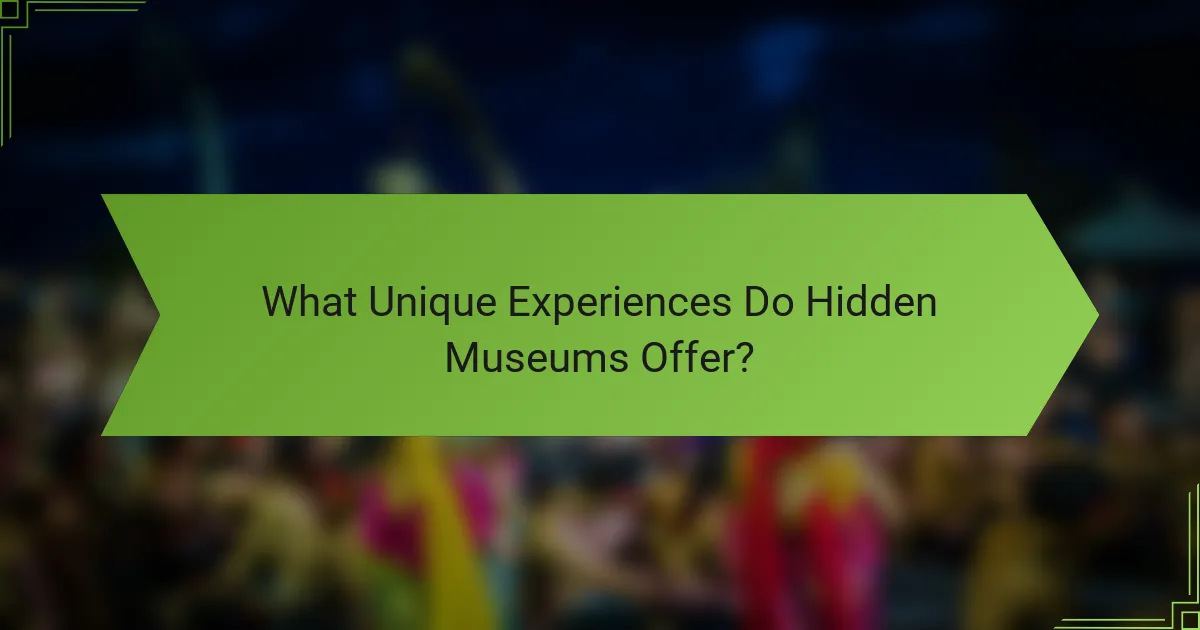
What Unique Experiences Do Hidden Museums Offer?
Hidden museums provide distinctive experiences that blend cultural heritage with local art, often showcasing lesser-known collections and interactive formats. Visitors can engage with exhibits in a more personal way, gaining insights into the local community and its artistic expressions.
Interactive Exhibits
Interactive exhibits in hidden museums allow visitors to engage directly with the art and artifacts, often through hands-on activities or digital interfaces. This approach enhances learning and retention, making the experience more memorable. For example, some museums may offer touchable replicas or augmented reality features that bring historical contexts to life.
When visiting, look for opportunities to participate in guided interactions or feedback sessions, which can deepen your understanding of the exhibits. Be prepared for a more immersive experience compared to traditional museums, where viewing is often passive.
Curated Tours by Local Experts
Curated tours led by local experts provide unique insights into the hidden treasures of a museum. These guides often share personal stories and cultural anecdotes that enrich the experience, making it more relatable and engaging. Tours can vary in length, typically lasting from one to two hours, depending on the depth of the content covered.
Consider joining a tour that focuses on specific themes, such as local history or contemporary art, to tailor your experience. Booking in advance is advisable, especially for popular tours, to ensure you secure a spot.
Workshops and Classes
Workshops and classes offered by hidden museums allow visitors to explore their creativity while learning about local art techniques. These sessions can range from painting and sculpture to traditional crafts, often led by skilled artisans or educators. Prices for workshops typically vary, with some being free or included with admission, while others may charge a nominal fee.
Participating in a workshop not only enhances your artistic skills but also fosters connections with other attendees. Check the museum’s schedule in advance to find classes that align with your interests and book early to avoid disappointment.
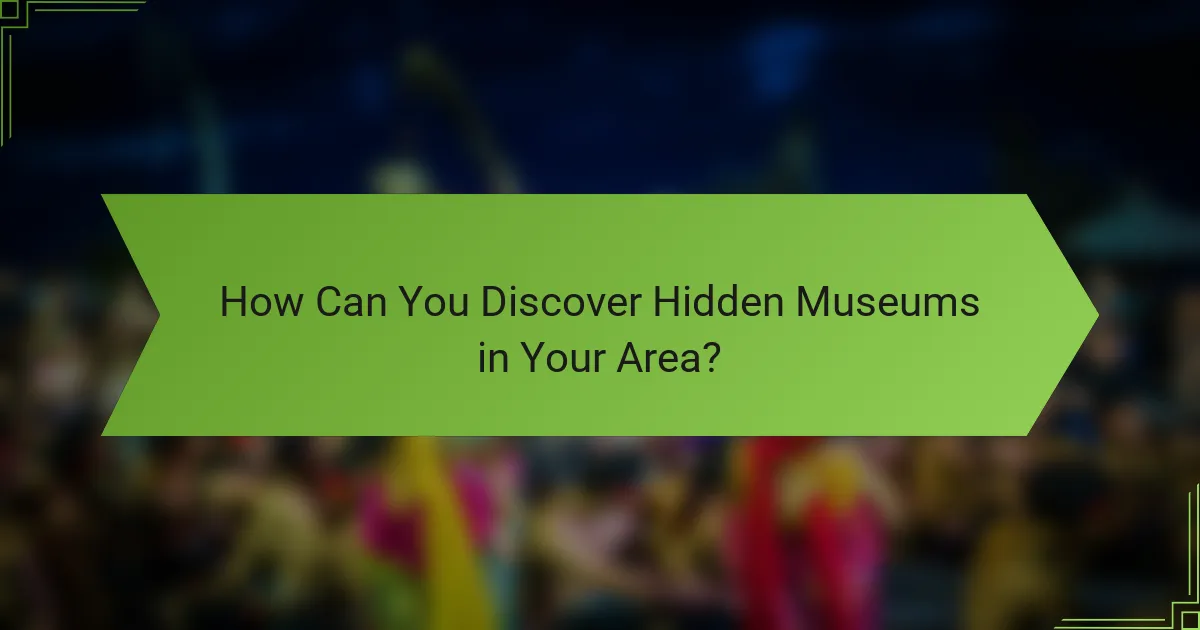
How Can You Discover Hidden Museums in Your Area?
To discover hidden museums in your area, start by exploring local resources and engaging with your community. These lesser-known cultural gems often rely on word-of-mouth and local recommendations, making it essential to tap into various platforms and events.
Local Guides and Apps
Local guides and apps can be invaluable for finding hidden museums. Look for city-specific travel apps or websites that focus on unique attractions, as they often feature user-generated content and reviews. Popular platforms like Yelp or TripAdvisor can also help you identify lesser-known spots based on community feedback.
Consider downloading apps that specialize in cultural experiences, such as Culture Trip or Atlas Obscura. These resources often curate lists of hidden gems, including museums that may not be widely advertised.
Social Media Recommendations
Social media is a powerful tool for discovering hidden museums. Platforms like Instagram and Facebook allow users to share their experiences and recommendations, often highlighting unique local attractions. Search for hashtags related to your city or specific interests, such as #HiddenMuseums or #LocalArt.
Join local community groups or forums where residents share tips and suggestions. Engaging with these online communities can lead to discovering museums that may not be on the typical tourist radar.
Community Events and Festivals
Attending community events and festivals is an excellent way to uncover hidden museums. Many local cultural events feature pop-up exhibitions or collaborations with nearby museums, showcasing their collections and programs. Keep an eye on local calendars for art walks, cultural festivals, or open studio events.
Participating in these events can also provide opportunities to meet museum curators and local artists, offering deeper insights into the cultural heritage of your area. Look for events that specifically promote local art and history to maximize your experience.
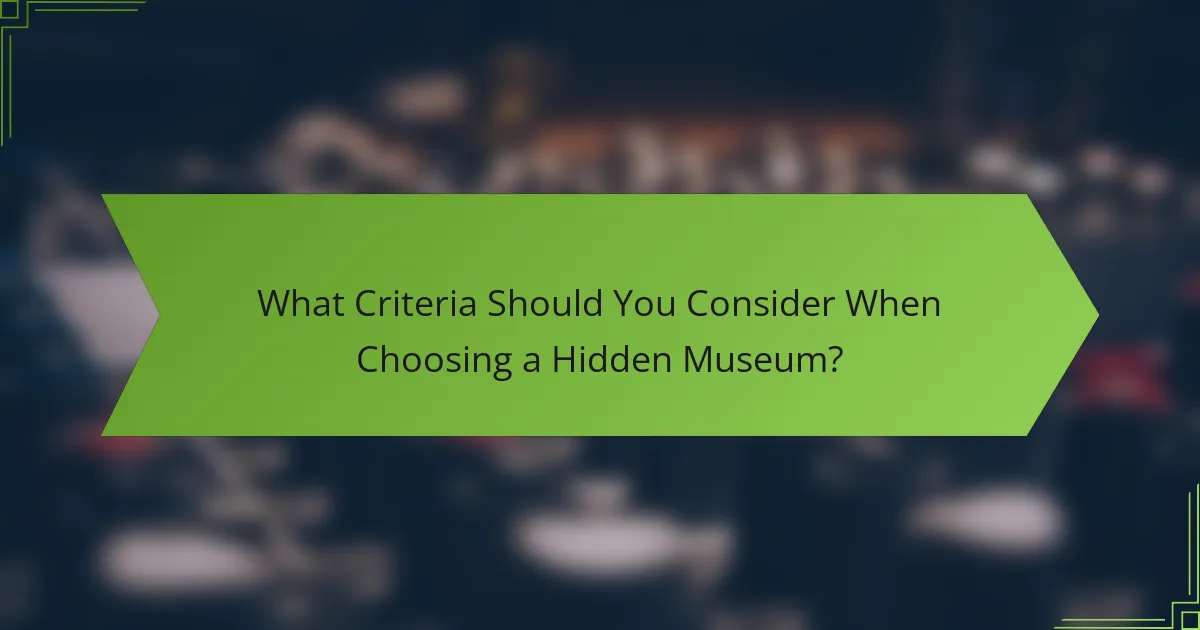
What Criteria Should You Consider When Choosing a Hidden Museum?
When selecting a hidden museum, consider factors such as accessibility, location, and visitor reviews. These elements can significantly impact your overall experience and help you discover unique cultural offerings.
Accessibility and Location
Accessibility refers to how easy it is to reach the museum and navigate its facilities. Look for museums that are conveniently located near public transportation or have ample parking options. Additionally, check if the museum is wheelchair accessible and offers services for visitors with disabilities.
Location can enhance your visit by placing you in an area rich with local culture. Consider hidden museums situated in vibrant neighborhoods or near other attractions, allowing you to explore more of the local art scene and heritage during your trip.
Visitor Reviews and Ratings
Visitor reviews and ratings provide valuable insights into the hidden museum’s quality and appeal. Check platforms like Google Reviews or TripAdvisor to gauge overall satisfaction and specific highlights or drawbacks mentioned by previous visitors.
Look for patterns in the feedback. For instance, if multiple reviews mention engaging exhibits or knowledgeable staff, those are strong indicators of a worthwhile visit. Conversely, consistent complaints about accessibility or lack of information may warrant reconsideration.


